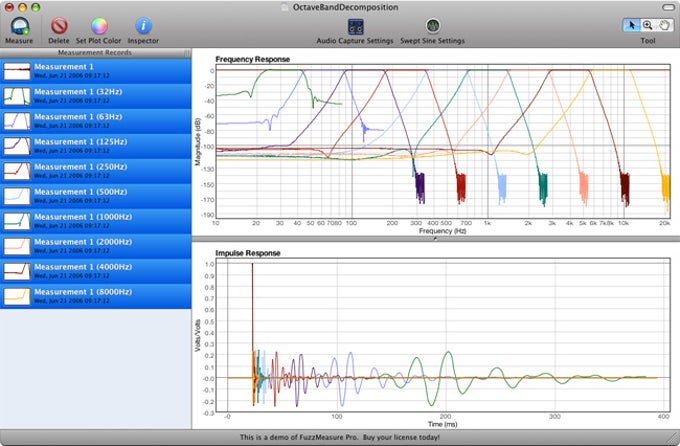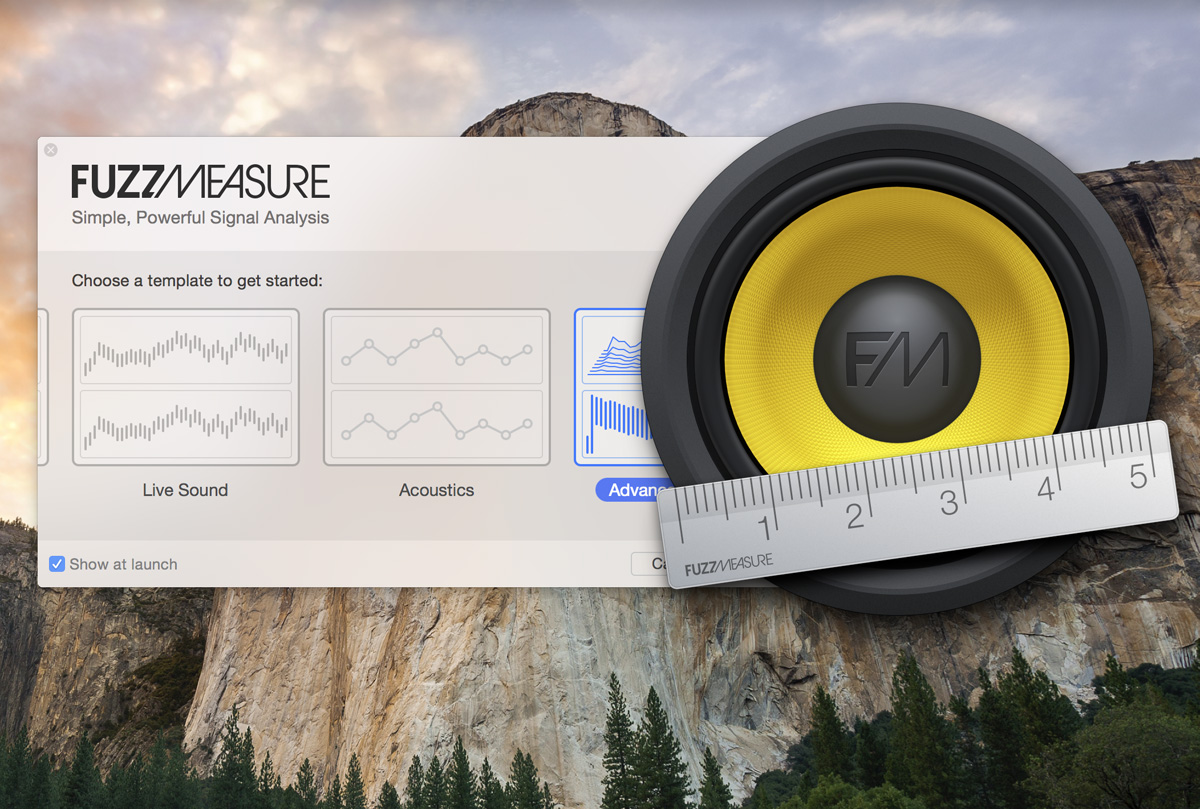Architectural acoustics is more complicated than it should be. There's a lot of work to do. FuzzMeasure is simple and affordable - the kind of tool that will empower the next generation of designers, consultants, and researchers.
Fuzzmeasure Review

To be able to show both the Waterfall and Reverb Time (RT60) graphs at the same time [in FuzzMeasure 4], without having to close one and then open the other, will save a lot of time as far as them grasping the scope of problems in the space.
- FuzzMeasure is designed to make measurements as easy and accurate as possible. FuzzMeasure was developed exclusively for Mac OS X with Cocoa and CoreAudio technologies. By leveraging Cocoa, FuzzMeasure looks and works just like the rest of the applications you're already using on your Mac.
- FuzzMeasure is a supremely clean-looking application. One of its windows represents a single ‘.fume4’ document, which contains the audio recordings associated with one or many sine-sweep measurements, as well as all the various customisable visual analyses that go along with it. The screenshot shows a typical FuzzMeasure view.
I’m not a trained acoustician, I’m an audio engineer. I'm not the guy designing rooms on a piece of paper, but I can tell you if a room sounds good or not. That’s why I like FuzzMeasure. A lot of clients just want you to tune the room fast and FuzzMeasure has definitely expedited the process.
FuzzMeasure is an audio and acoustic measurement tool to produce, analyze, and publish beautiful graphs. It delivers a comprehensive suite of features for professionals in research, acoustics, live sound, room design, and pro audio. By combining sophisticated technology with an elegant user interface, FuzzMeasure offers an unparalleled experience.
A lot of mastering engineers don’t do their own room scans however I feel that you have to know how to do your own work in case something gets accidentally moved or bumped. Before FuzzMeasure, I did all this by ear. FuzzMeasure is one of the many helpful tools I use to do my job effectively.
A subwoofer can do wonders to fill out the sound of small speakers in a home studio situation. They can also be especially useful for mixing, mastering, and video post-production work by extending the range of your system to reveal ultra-low frequencies that most monitors can’t reproduce. However, unless it’s calibrated to provide the right amount of bass in a particular range of frequencies, adding a subwoofer can actually do more harm than good to your music by throwing off the accuracy of your system with too much low-end.
A cranked subwoofer filling the room with bass can make your music sound instantly more satisfying, but monitoring with an exaggerated amount of low-end can seriously distort your perspective when recording, mixing, and mastering.
Because everything automatically sounds full, it won’t seem like you need to add much low-frequency content to your tracks—but when you play the finished product on a typical stereo, in a car, with earbuds, or through laptop or phone speakers, all that missing low-end will reveal a thin, weak, and harsh-sounding version of your mix.
Does Your Home Studio Need a Subwoofer?
Fuzzmeasure Vs Rew
Before clicking “buy” on the first subwoofer that catches your fancy, take some time to analyze your home studio setup and decide if you really even need one in the first place. If you currently use bookshelf or hi-fi speakers, you should first consider upgrading to a pair of studio-quality monitors with at least four- to six-inch woofers. These will exhibit a much flatter frequency response than consumer stereo speakers and will produce frequencies down to about 50Hz (albeit with a bit less output on the low-end).
If you currently use small monitors and still find yourself lacking in bass, simply upgrading to larger speakers could solve your problems without the complications of adding a subwoofer. Eight-inch woofers in a well-built speaker cabinet with proper bass porting can extend down to about 35Hz. Those 15 extra hertz will make a huge difference in bass content and may be all you need for satisfactory sound.
Monitors with larger woofers will get your system closer and closer to the lower limit of human hearing (20Hz), but at a certain point it may be more effective and more economical to add a subwoofer to your setup. Some people even use two subwoofers for a fully stereo system, but this article will focus on single-subwoofer setups.
Choosing a Subwoofer
In most cases, if the manufacturer of your monitors sells a subwoofer for that particular line of speakers, that should be your first choice. With a matching subwoofer, you’ll know for sure that the entire system was designed to work together, with the sub tuned to provide exactly what your monitors are missing. But if there isn’t a dedicated subwoofer for your specific set of monitors (or if it you can't find one or afford it), try to get the closest thing possible from the same brand, and you should still have a decent match.
In the absence of an obvious match for your monitors, you’ll need to learn a bit about the different types of subwoofers available to make the right choice for your setup. Like any other speaker, a subwoofer can be “active” (powered) or “passive” (unpowered).
Most modern subwoofers are of the active variety, meaning that they contain an internal amplifier that requires external power. Passive subwoofers are slightly less common in the pro audio realm, being more of a consumer hi-fi option. However, they can perform just as well as active models with a good amplifier to power them.
Crossovers
In addition to the subwoofer itself, you will need a crossover: a circuit that splits the incoming audio signal into low- and high-frequency bands to be sent to the subwoofer and the monitors, respectively.
Many active/powered subwoofers, like the Yamaha HS8S, feature an internal crossover, meaning you can simply connect them between your audio interface (or mixer) and your monitors, and everything technical happens automatically inside the subwoofer. However, since your entire audio signal will pass through the subwoofer’s electronics, make sure you choose a high-quality model that won’t degrade the audio on its way through.
Another option is to get an external crossover unit like the dbx 223xs. This will require a more advanced setup but can help you dial in much more specific settings to perfect the frequency balance of your system.
Lastly, dedicated monitor controllers like the Radial MC3 or the Drawmer CMC3 (and certain analog consoles) often feature a dedicated mono output for a subwoofer. In some cases, you may need to manually filter the signal going to the sub, but certain high-end monitor controllers also feature internal crossovers.
How to Set up a Subwoofer

Once you know how your subwoofer will integrate into your system, you’ll need to decide where to put it. Since lower frequencies are much less directional than high frequencies, you don’t have to worry about super-specific placement—anywhere on the floor near your desk should be fine. What does matter is your subwoofer’s proximity to walls and corners. Any nearby boundary will naturally increase the sub’s volume and distort its frequency response, so keep it away from walls and corners unless you really know what you’re doing.
When connecting your equipment, always use the highest-quality shielded cables you can afford (with the shortest length possible) to avoid noise, interference, and signal degradation.
Next, you’ll need to set the crossover frequency so that it takes over right where your speakers leave off. This is a crucial step because without a crossover, your sub and monitors would receive the same input and overlap in the low-midrange, creating a muddy sound.
Refer to the technical manual for your monitors and look for the frequency response graph, which shows the range of frequencies in which your speakers are most effective. You’ll notice that the response drops off somewhere between 20Hz and 100Hz—this is roughly where you’ll want to set the crossover. If there’s a bump or a dip in the response just before it drops off, you may want to set the crossover frequency higher to avoid it.
Fine-Tuning Your Subwoofer
After setting the crossover frequency, it’s time to fine-tune your subwoofer’s output level to provide the right amount of bass. Acoustical measurement software like Fuzzmeasure or RoomEQWizard is extremely helpful here, as the only way to achieve a flat response is by trial and error: Set the level, record a measurement with a test tone, make an adjustment, and repeat until the reading is as flat as you can get it.
If you are unable to empirically measure your room’s acoustics, listen to a variety of reference tracks and adjust the sub level until every song sounds full yet realistic (in other words, not exaggerated), and you’ll be in the ballpark.
If for some reason you’re seeing or hearing less bass (or some other unexpected anomaly) after hooking up your subwoofer, you may be experiencing phase cancellation. Due to the nature of how low-frequency sound waves resonate in a room, certain frequencies can be cancelled out if your subwoofer is in just the wrong spot.

Many subwoofers and crossover units have a button that inverts the phase of the signal to counteract this effect, but you can also use a specially wired cable or physically move your sub out of the problematic spot in the room.
